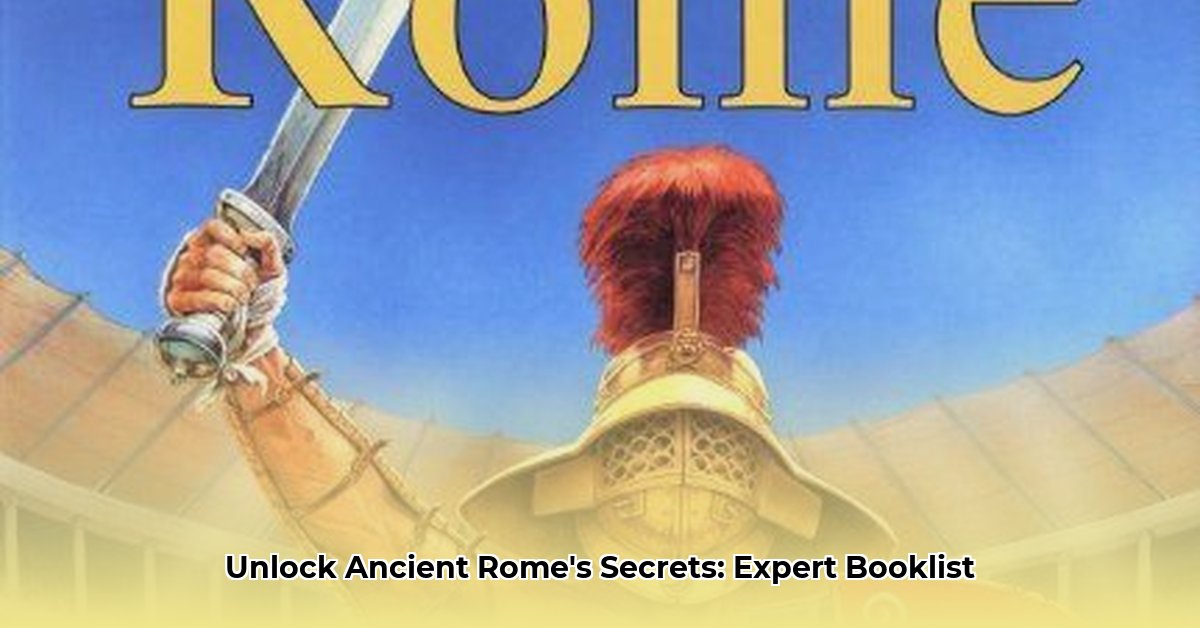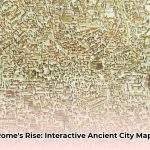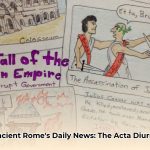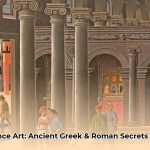Are you ready to transcend the typical narratives of emperors and gladiators and truly understand the pulse of ancient Rome? Forget the dusty textbooks for a moment. We’re embarking on a journey through the best books on ancient Rome, exploring volumes that don’t just recount history but peel back its intricate layers, revealing untold longtail insights into its political machinations, societal structures, profound environmental impacts, and the vibrant tapestry of daily life. For more book options, see our full recommendations.
This is your definitive guide to becoming a bona fide Roman history connoisseur, equipped not just with facts, but with the critical tools to interpret the past. We’ll uncover why certain historical accounts offer crucial, albeit sometimes biased, insights, how even compelling fictional works can illuminate the human experience of the past, and why the Roman saga still resonates powerfully in our modern world.
To genuinely grasp the profound complexities of the Roman world, a multifaceted approach is indispensable. As you delve into these works, keep these three pivotal tenets in mind:
- Embrace Diverse Perspectives: The most profound understandings of ancient Rome frequently emerge from sources that extend beyond grand political and military narratives. Seek out works delving into social history, environmental impacts, the often-overlooked experiences of women and marginalized groups, and even the interpretive power of historical fiction. These expand your view beyond the imperial elite.
- Cultivate Critical Engagement: It is paramount to approach all historical texts, from ancient biographies like Suetonius’s The Twelve Caesars to modern scholarly analyses, with a discerning eye. Distinguish between factual reporting, contemporary perceptions, and the inherent biases of the era or the author. Understanding who wrote what and why is key to unlocking deeper truths.
- Recognize Contemporary Relevance: By meticulously examining Roman challenges—from persistent political strife and profound societal inequality to the devastating impacts of climate change and epidemics—we gain invaluable contexts. These historical parallels offer potent lessons for understanding and addressing our own pressing modern-day complexities, reaffirming that history is not merely a chronicle of the past but a mirror reflecting the present.
The Definitive Roman Library: Essential Books for Every Explorer
What is it about ancient Rome that continues to captivate us centuries later? Perhaps it’s the potent blend of boundless ambition, ruthless political games, unparalleled engineering prowess, and a profound, enduring legacy that echoes in our own societal structures, legal systems, and even our language. To truly grasp this colossal civilization, we must turn to the essential books on Roman history that offer unique glimpses into their world, shaping our own understanding in the process.
Here’s a curated selection of books, ranging from comprehensive overviews to specialized studies, that will deepen your appreciation for this magnificent, often brutal, and always fascinating empire.
Comprehensive Overviews & Foundational Reads
These books provide a robust entry point for any budding Roman historian, offering broad narratives while maintaining scholarly rigor and engaging prose.
SPQR: A History of Ancient Rome by Mary Beard
- Our Take: For a comprehensive yet wonderfully accessible overview of Roman history, Mary Beard’s SPQR is simply brilliant. Beard, a leading classicist known for her captivating TV documentaries and witty public commentary, possesses an extraordinary knack for making intricate topics understandable without ever condescending to her readers. She takes you from Rome’s humble origins as a small Iron Age village to the complexities of the Roman Empire, meticulously weaving together political developments, social commentary, and archaeological evidence with her characteristic wit and clarity. What makes SPQR exceptional is its ability to demystify complex subjects, connecting the dots between ancient experiences and our contemporary world with fresh insights. It’s the ideal foundation before venturing into more specialized reads, demonstrating how history is a continuous dialogue between past and present.
Rubicon: The Last Years of the Roman Republic by Tom Holland
- Our Take: Ready for a dive into political intrigue that feels unsettlingly familiar? Tom Holland, a gifted popular historian who began his career as a novelist, plunges you into the tumultuous final decades of the Roman Republic. Holland paints a vivid, almost cinematic, picture of rampant political violence, unbridled personal ambition, and the slow, agonizing erosion of republican ideals. From the dramatic Gracchi brothers to the towering figure of Julius Caesar, Holland brings to life the larger-than-life personalities who shaped this pivotal period. Rubicon masterfully illustrates how seemingly minor decisions can trigger immense consequences, and how the relentless pursuit of power can ultimately dismantle even the most cherished institutions – a valuable, cautionary lesson for any democracy.
The Decline and Fall of the Roman Empire by Edward Gibbon
- Our Take: Published in six volumes between 1776 and 1788, Gibbon’s magnum opus chronicles the decline and fall of the Roman Empire from its zenith to its eventual fragmentation. While undoubtedly a product of its time (with certain biases and outdated historical interpretations), Gibbon’s work remains a monumental achievement of scholarship and literary style. His elegant prose, incisive wit, and monumental scope continue to influence historians. Reading Gibbon is not just about learning facts; it’s an immersive experience in the art of historical narrative and a testament to the enduring fascination with Rome’s eventual demise. It’s a work that demands patience but offers immense rewards.
Emperors, Politics & Power
These books delve into the lives of Rome’s most influential figures and the political machinations that shaped the Republic and Empire.
The Twelve Caesars by Suetonius
- Our Take: If you’re after a truly unvarnished, often scandalous, look at the Roman emperors, look no further than Suetonius’s The Twelve Caesars. This isn’t your dry academic tome; it’s the ancient Roman equivalent of a celebrity tell-all, brimming with juicy details, scandals, and undoubtedly a good deal of exaggeration. Written by Gaius Suetonius Tranquillus, a Roman biographer with unparalleled access to imperial archives, this infamous work offers an unparalleled insight into how the Romans themselves perceived their leaders—the benevolent, the terrible, and the utterly mad. It’s a crucial resource for understanding the cultural fabric and societal values of the time, even if its historical accuracy occasionally veers into the realm of the sensational. (More on how to read Suetonius critically below!)
Ten Caesars: Roman Emperors from Augustus to Constantine by Barry Strauss
- Our Take: Barry Strauss, a skilled narrative historian, tells the sweeping story of the Roman Empire’s rise and fall through the lives of ten of its most famous rulers, beginning with Julius Caesar and ending with Constantine. Strauss paints a broad picture of Roman history that is both fascinating and complex. While each emperor has a unique story, Strauss also highlights the common themes that link their lives together: the machinations of politics, the power of personality, and the relentless importance of military strength. Ten Caesars is an accessible and gripping read for anyone looking to understand the core imperial narrative.
Augustus: First Emperor of Rome by Adrian Goldsworthy
- Our Take: Adrian Goldsworthy, a prolific and respected military historian, delivers a masterful biography of Augustus, one of history’s most important and influential figures. Goldsworthy meticulously traces Augustus’s life from his formidable youth through his military campaigns and subsequent rise to power, culminating in the establishment of the Principate and the Pax Romana. He paints a vivid portrait of the man, his character, and his motivations, providing readers with a nuanced understanding of why Augustus was so successful in consolidating power and creating the Roman Empire. Goldsworthy excels at situating Augustus within the broader context of Roman history, making this an essential read for understanding Rome’s most transformative period.
Cicero: The Life and Times of Rome’s Greatest Politician by Anthony Everitt
- Our Take: Anthony Everitt’s biography offers an elegant and readable portrait of Marcus Tullius Cicero, Rome’s greatest orator and a pivotal figure in the late Republic. Through Cicero’s eyes, we witness the scandal and turmoil of a period teetering on the brink of civil war. Everitt, a litterateur turned historian, leverages Cicero’s own voluminous writings—especially his letters—to bring to life a brilliant, often pompous, but ultimately principled antihero forced to navigate a collapsing political system. The book is deeply researched and dramatically told, making the complexities of Republican power-brokering both clear and compelling.
Social, Cultural & Daily Life
These books illuminate the everyday realities, social norms, and often-overlooked aspects of Roman society, moving beyond the elite and the battlefield.
The Fate of Rome: Climate, Disease, and the End of an Empire by Kyle Harper
- Our Take: Kyle Harper’s The Fate of Rome offers a radical, and chillingly relevant, reinterpretation of the Roman Empire’s decline. He argues that the traditional narratives of moral decay and political corruption miss a crucial piece of the puzzle. Harper, an environmental historian, posits that a series of profound environmental shocks, including volcanic eruptions that altered climate patterns and devastating plagues like the Antonine and Justinianic Plagues, severely weakened the Roman state, making it far more vulnerable to external pressures. What makes this book so compelling is its direct relevance to our own era. In a world grappling with climate crisis and global pandemics, Harper’s meticulous analysis of the Roman experience serves as a stark, poignant reminder of civilization’s inherent fragility and interconnectedness with the natural world.
Domina: The Women Who Made Imperial Rome by Guy de la Bédoyère
- Our Take: While much has been written about the great Roman emperors, Guy de la Bédoyère brings to light the stories of the often-overlooked women who wielded significant power behind the scenes. Domina is a fascinating exploration of the lives of women in Ancient Rome, from the wives of prominent figures like Sulla and Julius Caesar to influential empresses such as Messalina and Agrippina the Younger. De la Bédoyère paints a vivid picture of life in Imperial Rome, highlighting the diverse roles women played in shaping its history. Through their individual narratives, we gain a greater understanding of the complex social world of Ancient Rome and how power was negotiated and wielded by both men and women.
Daily Life in Ancient Rome: The People and the City at the Height of the Empire by Jérôme Carcopino
- Our Take: First published in 1939 but still highly regarded, Carcopino’s Daily Life in Ancient Rome offers a foundational and fascinating look at everyday existence in one of history’s most iconic cities. Carcopino expertly brings to life the people and places of Ancient Rome, painting a vivid picture of what it was like to live in this bustling metropolis. Through his compelling narrative, we learn about the different social classes, how they interacted, their customs, beliefs, and even their eating habits and leisure activities. This book is an essential read for anyone interested in stepping beyond political history to grasp the tangible realities of Roman life.
The Corrupting Sea: A Study of Mediterranean History by Peregrine Horden and Nicholas Purcell
- Our Take: This ambitious and groundbreaking two-volume work offers a “microgeography” of the Mediterranean, arguing that the sea itself was a central organizing principle for the societies around it, including Rome. Horden and Purcell, both distinguished historians, explore how the unique characteristics of the Mediterranean—its climate, coasts, islands, and communication routes—shaped human civilization from prehistory to the early modern period. For Roman history, it offers a crucial environmental and economic perspective, revealing how trade, disease, and resource management were intrinsically linked to the sea. It’s a challenging but deeply rewarding read for those seeking to understand the fundamental forces that underpinned Roman power and daily life.
Perpetua’s Journey: Faith, Gender, and Power in the Roman Empire by Jennifer A. Rea and Liz Clarke
- Our Take: For history buffs who also appreciate visual storytelling, Perpetua’s Journey is a brilliant hybrid. This graphic interpretation of The Passion of St. Perpetua, the diary of an early Christian Roman woman martyred for her faith, brings this ancient document alive. Jennifer A. Rea, a classicist, provides sensitive historical commentary, situating Perpetua’s story within the turbulent social and religious context of the Roman Empire under Septimius Severus. Liz Clarke’s art vividly portrays Perpetua as a young mother confronting impossible circumstances, offering a unique and poignant glimpse into early Christianity and the experience of a woman in Roman Africa. It’s an indispensable teaching tool and a moving read for anyone interested in the intersection of faith, gender, and power in antiquity.
Wars, Battles & Defining Moments
For those captivated by Roman military might and strategic genius, these books offer detailed accounts of pivotal conflicts.
The War That Made the Roman Empire: Antony, Cleopatra, and Octavian at Actium by Barry Strauss
- Our Take: Barry Strauss, noted for his gripping narratives, delivers a fascinating account of one of the most pivotal moments in Roman history: the Battle of Actium in 31 BCE. This naval confrontation between Mark Antony and Cleopatra’s forces and those of Octavian determined the fate of Rome. Through meticulous research and clear writing, Strauss brings this dramatic clash to life, showing how Octavian’s decisive victory ultimately led to the formation of the Roman Empire and the end of the Republic. It’s essential reading for anyone seeking to understand how Rome transitioned from civil war to imperial rule.
The Ghosts of Cannae: Hannibal and the Darkest Hour of the Roman Republic by Robert L. O’Connell
- Our Take: O’Connell provides a detailed and engaging account of the Battle of Cannae, one of the most significant military engagements in history and a catastrophic defeat for Rome during the Second Punic War. He not only recounts the battle itself but delves into the larger context, painting a vivid picture of Hannibal, the brilliant Carthaginian general, and the Roman Republic brought to its knees. The Ghosts of Cannae is an essential read for anyone interested in military history, offering a fascinating glimpse into one of the darkest hours for the burgeoning Roman state.
Fictional Insights & Controversial Takes
Sometimes, fiction can illuminate historical truth, and challenging perspectives can force a deeper understanding.
I, Claudius by Robert Graves
- Our Take: Here’s a curveball: Robert Graves’ I, Claudius is a novel, not a historical work in the traditional sense. Yet, it has profoundly shaped popular perceptions of the Roman Empire for generations. Told from the seemingly hapless Emperor Claudius’s perspective, it’s a gripping tale of courtly intrigue, betrayal, and ruthless ambition within the Julio-Claudian dynasty. While not strictly accurate in every minute detail, I, Claudius perfectly captures the spirit of the era—the pervasive paranoia, the shocking decadence, and the ceaseless struggle for power. Think of it as exceptionally insightful historical fiction that breathes life into the characters, just remember to enjoy it with a critical eye, perhaps cross-referencing with scholarly sources for historical verification.
The Darkening Age: The Christian Destruction of the Classical World by Catherine Nixey
- Our Take: Catherine Nixey presents a provocative and controversial perspective on the rise of Christianity. She boldly suggests that early Christians actively suppressed classical knowledge, deliberately destroying pagan art and literature, and dismantling ancient philosophical traditions. It’s a stark and unsettling view of a period often framed as one of enlightenment, challenging conventional interpretations of the triumph of Christianity. Nixey compels readers to consider whether the rapid ascendance of this new religion was, in certain respects, a cultural catastrophe for the ancient world, leading to a “darkening” of intellectual inquiry and the loss of invaluable knowledge. It’s a book that sparks debate and encourages a nuanced understanding of a complex historical transition.
Deep Dive: Beyond the Headlines – Unpacking Imperial Lives with Suetonius
Suetonius, born around 69 AD, remains a captivating, albeit controversial, biographer of Roman emperors. While his exact birthplace is debated, he rose from an equestrian background to become a prominent figure in the imperial administration under emperors like Trajan and Hadrian. His seminal work, The Twelve Caesars, offers an intimate—and often scandalous—look at Rome’s most powerful rulers, from Julius Caesar to Domitian.
What Makes Suetonius Essential for Untold Roman Tales?
So, what makes Suetonius essential for untold Roman tales? It’s his unique combination of privileged access and a distinct penchant for anecdote. As ab epistulis (chief secretary) under Hadrian, he possessed unparalleled access to imperial archives and records. He wasn’t a historian in the grand, analytical mold of Tacitus; rather, he was a biographer who reveled in personal details, gossip, and quirky stories. This very approach makes him a valuable, yet inherently questionable, source. Can we truly understand a ruler without knowing if they had a habit of conversing with their horse? Suetonius thinks so. His work provides:
- Unique Vividness: Suetonius, despite his acknowledged limitations, provides uniquely vivid and personable insights into the lives and characters of the first twelve Roman emperors, offering color and detail often absent from more formal histories.
- Shaper of Perception: His unparalleled access to imperial archives, combined with a keen eye










